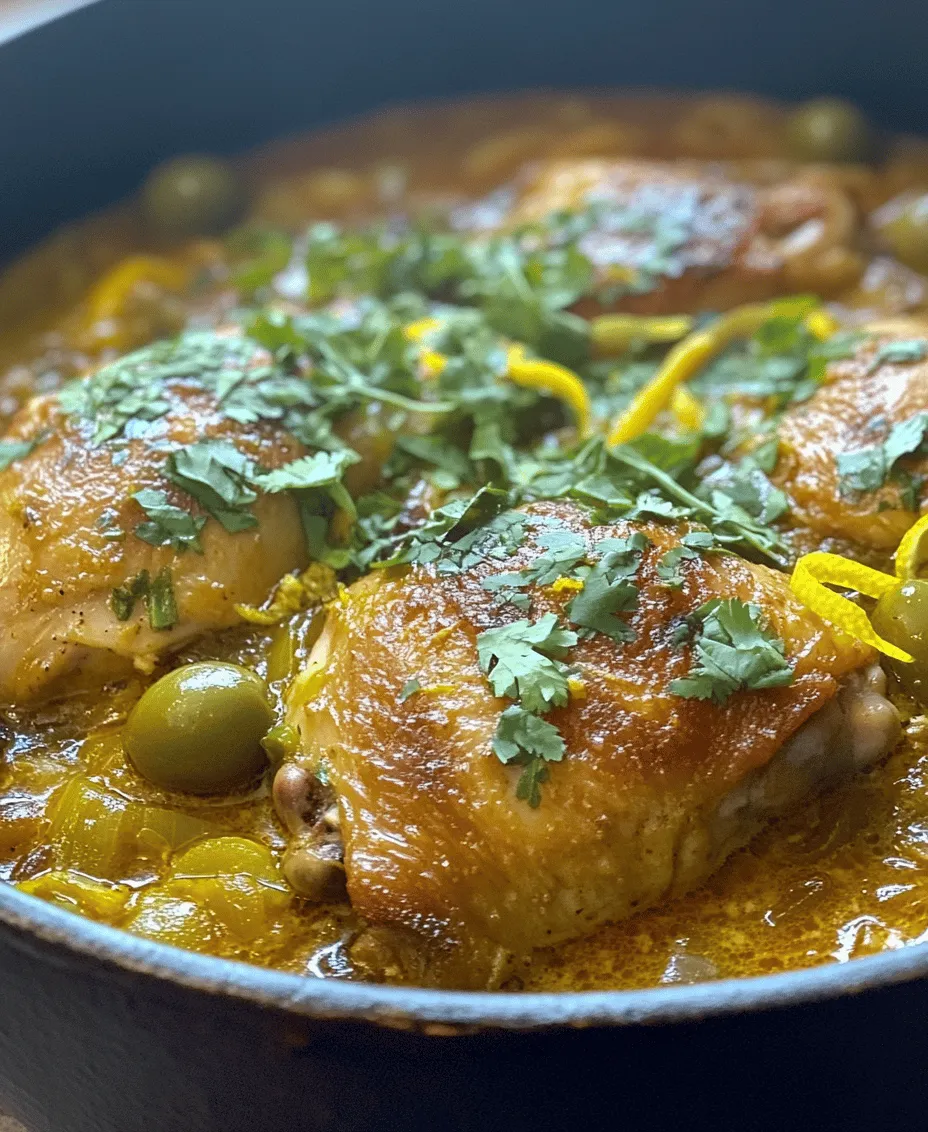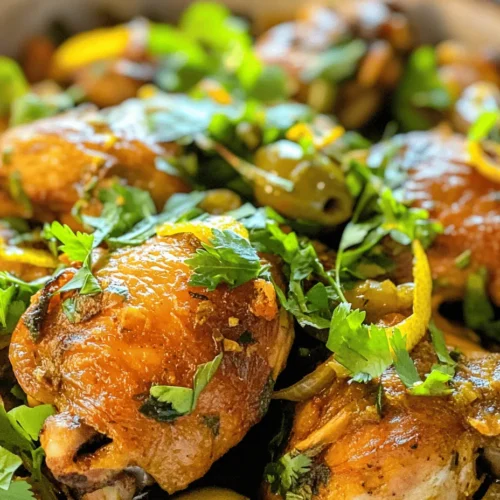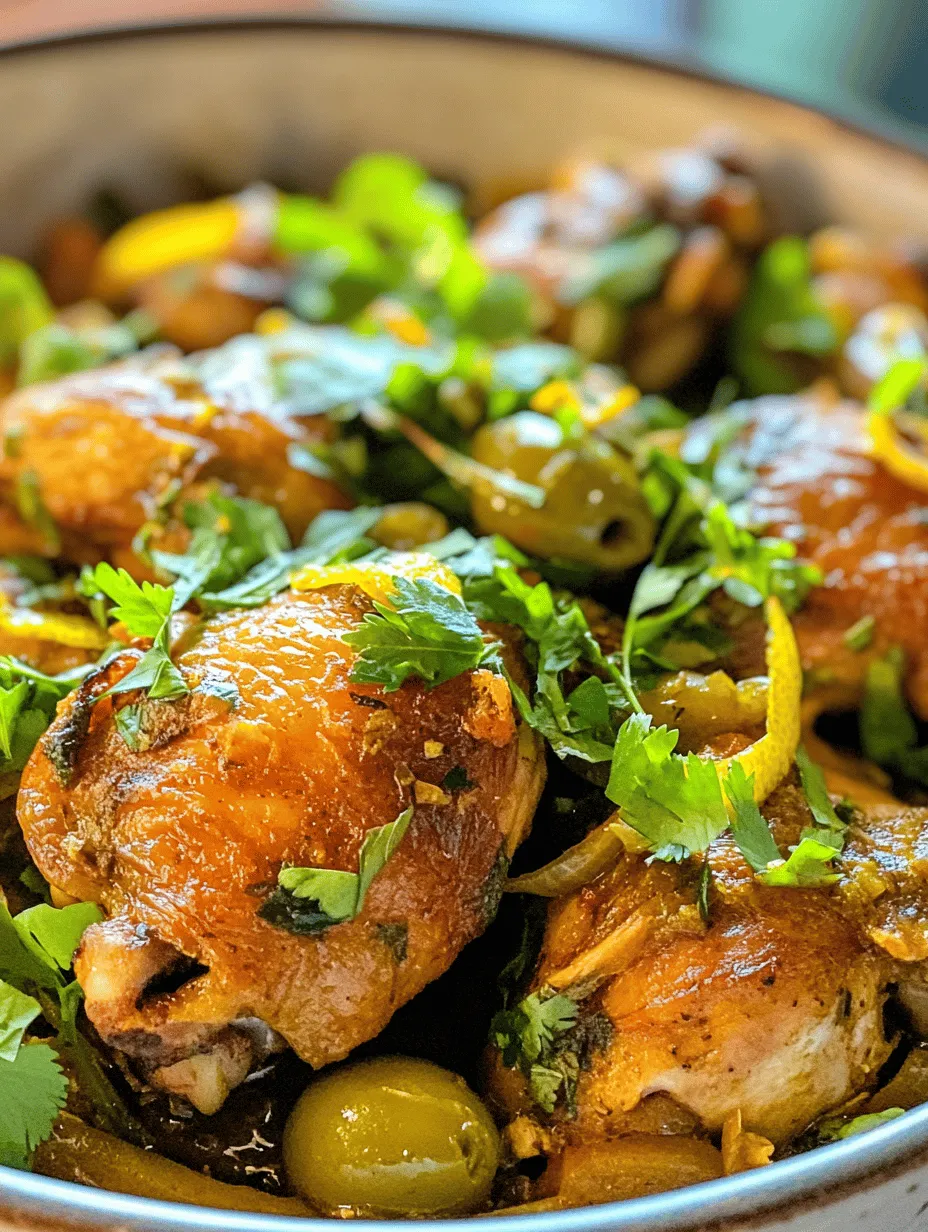Introduction
Moroccan cuisine is celebrated for its rich flavors, vibrant colors, and aromatic spices that transport you to the bustling markets of Marrakech or the tranquil deserts of the Sahara. At the heart of this culinary tradition lies the tagine, a unique cooking vessel that has been used for centuries to create slow-cooked, flavorful dishes. The tagine’s conical shape allows steam to circulate, ensuring that the ingredients remain tender and infused with the spices and herbs used in the cooking process.
One standout dish that embodies the essence of Moroccan cooking is Saffron-Infused Chicken Tagine with Olives & Lemons. This dish not only showcases the aromatic spices synonymous with Moroccan cuisine but also highlights the balance of flavors that make it so special. The combination of succulent chicken thighs, briny olives, and tangy preserved lemons creates a comforting and satisfying meal, perfect for gatherings and special occasions. Whether you are hosting a dinner party or simply looking to expand your culinary repertoire, this tagine is sure to impress.
Understanding Tagine Cooking
To truly appreciate the Saffron-Infused Chicken Tagine, it’s essential to understand the tagine itself. A tagine is a traditional Moroccan cooking pot made from clay or ceramic, characterized by its conical lid. This design is not just for aesthetics; it plays a crucial role in the cooking process. As the dish simmers, the conical lid traps steam, allowing moisture to condense and drip back into the dish, keeping the ingredients juicy and flavorful.
In Moroccan cooking, tagines are often used to prepare a variety of meats, vegetables, and even desserts. The slow-cooking method allows the spices to meld together, creating a depth of flavor that is hard to achieve with quicker cooking methods. While you can replicate the tagine experience using a Dutch oven, the authentic tagine pot provides a unique atmosphere that enhances the cooking and dining experience, providing a connection to Moroccan culture and traditions.
Ingredients Breakdown
The ingredients in Saffron-Infused Chicken Tagine with Olives & Lemons are thoughtfully chosen to create a harmonious blend of flavors. Here’s a breakdown of each ingredient and what it brings to the dish:
– Chicken Thighs: For this recipe, bone-in, skin-on chicken thighs are preferred. This choice is essential for both flavor and moisture. The skin renders fat during cooking, contributing a rich base to the sauce, while the bones add depth of flavor that boneless cuts simply cannot match. The result is tender, juicy chicken that absorbs the aromatic spices beautifully.
– Saffron: Known as the world’s most expensive spice, saffron adds a unique flavor and vibrant yellow hue to the dish. Its delicate floral notes elevate the overall taste, making it a key component of this tagine. Additionally, saffron is believed to have various health benefits, including mood enhancement and antioxidant properties.
– Spices: The spice blend in this tagine is essential to achieving its signature Moroccan flavor. Ground ginger adds warmth, while cinnamon contributes a subtle sweetness that balances the dish. Turmeric not only deepens the color but also brings a slightly earthy undertone. Together, these spices create a complex flavor profile that is comforting and aromatic.
– Olives: Green or black olives add a briny, savory element that complements the chicken and spices. They provide a satisfying texture and a burst of flavor, making them an integral part of the dish. The olives also help to cut through the richness of the chicken, creating a well-rounded meal.
– Preserved Lemons: A staple in Moroccan cuisine, preserved lemons introduce a tangy brightness that elevates the dish. The fermentation process softens the lemons and intensifies their flavor, providing a unique balance of acidity and sweetness. When combined with the other ingredients, preserved lemons enhance the overall complexity of the tagine.
– Fresh Herbs: Lastly, fresh herbs like cilantro or parsley are used for garnishing. They add a pop of color and freshness, brightening the dish just before serving. Herbs also provide a finishing touch that complements the rich flavors of the tagine.
Preparation Steps for Saffron-Infused Chicken Tagine
Marination Process
Before diving into the cooking process, marinating the chicken is a crucial step that cannot be overlooked. Marination allows the chicken to absorb the flavors of the spices and aromatics, resulting in a more flavorful and tender final dish. For the Saffron-Infused Chicken Tagine, a simple yet effective marinade is used, consisting of saffron, ginger, cinnamon, turmeric, salt, and a splash of olive oil.
To marinate the chicken, follow these steps:
1. Prepare the Marinade: In a bowl, combine the saffron threads with a few tablespoons of warm water to help release their flavor. Add ginger, cinnamon, turmeric, salt, and olive oil, mixing until well combined.
2. Marinate the Chicken: Place the chicken thighs in a large resealable bag or bowl and pour the marinade over the top. Ensure that each piece is well coated. Seal the bag or cover the bowl and refrigerate for at least 2 hours, though overnight is ideal for maximum flavor infusion.
3. Optimal Marination Time: For best results, aim for a marination time of 12 hours. This allows the spices to penetrate deeply into the chicken, ensuring that every bite is packed with flavor.
Sautéing Aromatics
Once the chicken is adequately marinated, the next step is to sauté the aromatics. This step is essential for building the foundational flavors of the tagine.
1. Heat the Tagine (or Dutch Oven): Begin by placing your tagine on the stove over medium heat. If using a Dutch oven, heat it on the stovetop as well. Add a generous amount of olive oil to the pot.
2. Sauté Onions: Once the oil is shimmering, add finely chopped onions. Sauté the onions for about 5-7 minutes, or until they are soft and translucent. This process releases their natural sweetness, which will balance the spices in the dish.
3. Add Garlic: After the onions have softened, add minced garlic to the pot. Sauté for an additional 1-2 minutes, stirring frequently to prevent burning. The aroma of the garlic will enhance the overall fragrance of the dish.
4. Building the Base Flavor: The combination of sautéed onions and garlic creates a robust base for your tagine. This aromatic foundation is crucial, as it will infuse the chicken and other ingredients with rich flavors during the cooking process.
Browning the Chicken
With the aromatics sautéed to perfection, it’s time to brown the marinated chicken. This step adds depth of flavor and a beautiful golden color to the dish.
1. Add Chicken to the Pot: Carefully place the marinated chicken thighs skin-side down in the pot. Allow them to brown for about 5-6 minutes without moving them. This helps to achieve a crispy skin that enhances the texture of the final dish.
2. Flip and Brown the Other Side: Once the first side is golden brown, flip the chicken pieces over and cook for an additional 5 minutes. Browning the chicken not only adds flavor but also seals in the juices, keeping the meat moist during the cooking process.
3. Remove the Chicken: After browning, remove the chicken from the pot and set it aside. This step allows you to build the sauce before returning the chicken to finish cooking.
As you prepare to continue with your Saffron-Infused Chicken Tagine, you will soon see how these initial steps set the stage for a truly flavorful and satisfying dish. The combination of marinated chicken, aromatic spices, and the unique tagine cooking method will culminate in a meal that is sure to impress your family and guests alike.

Tips for Achieving a Golden-Brown Crust on the Chicken Thighs
To achieve that coveted golden-brown crust on your chicken thighs, start by ensuring that your pan is adequately heated before adding the chicken. A hot pan helps to sear the meat, locking in juices while developing a rich flavor. Use a blend of olive oil and butter for browning; the olive oil provides high smoke points, while the butter adds richness and depth of flavor.
When placing the chicken in the pan, avoid overcrowding. If necessary, cook the thighs in batches to ensure that each piece has enough space to brown evenly. Let the chicken sit undisturbed for a few minutes on each side before flipping. This allows for a more effective sear. The right time will depend on your stovetop heat, but aim for about 4-5 minutes per side. You’ll know it’s ready to turn when it releases from the pan easily and has developed a deep golden color.
Importance of Browning for Depth of Flavor
Browning is not just for aesthetics; it plays a crucial role in enhancing the dish’s overall flavor. The Maillard reaction occurs when the chicken is seared at high heat, resulting in complex flavors and aromas that form the foundation of your tagine. These proteins and sugars react to create a crust that is savory and flavorful, which ultimately contributes to the richness of the sauce. Skipping this step may lead to a flat-tasting dish, so don’t rush this essential part of the cooking process.
Building the Sauce
Once your chicken is browned to perfection, it’s time to build the sauce. Begin by deglazing the pan with chicken broth, scraping the bottom with a wooden spoon to incorporate all those flavorful brown bits. Add fresh lemon juice and zest to the mix; this balance of acidity and brightness will cut through the richness of the chicken and add a refreshing element to the dish.
Preserved lemons are a star ingredient in this tagine. Their unique tang and slightly sweet flavor elevate the dish significantly. The peel is the most flavorful part, so chop it finely and add it to the sauce, allowing it to infuse as it simmers. If you can’t find preserved lemons, you can substitute with a combination of fresh lemon juice and a pinch of salt, but the flavor will not be as intricate.
Simmering Techniques
Slow cooking is key to a successful tagine. Once the sauce is combined, return the chicken to the pot, ensuring it’s submerged in the liquid. Cover the pot with a lid and reduce the heat to low, allowing it to simmer gently. This slow cooking method is essential as it allows the flavors to meld beautifully, ensuring that the chicken absorbs the aromatic spices, saffron, and the citrus elements.
During the simmering process, check the chicken for doneness. The thighs should be tender and easily pull away from the bone. If using a meat thermometer, aim for an internal temperature of 165°F (74°C). The chicken should also be coated in a thick, flavorful sauce by the end of the cooking time.
Incorporating Olives for Flavor
Adding olives is a crucial step in finishing your saffron-infused chicken tagine. To preserve their texture and flavor, incorporate them into the dish about 15 minutes before serving. This timing allows the olives to warm and infuse their salty, briny notes into the sauce without becoming overly soft.
When selecting olives, consider varieties like green Castelvetrano or Kalamata olives. Castelvetrano olives are sweet, mild, and buttery, contrasting beautifully with the dish’s other flavors. Kalamata olives, on the other hand, are more assertive and tangy, providing a bold punch. Feel free to mix varieties for added depth and complexity.
Garnishing and Serving Suggestions
Garnishing your saffron-infused chicken tagine enhances both its visual appeal and flavor profile. Consider sprinkling chopped fresh herbs such as cilantro or parsley just before serving. These herbs not only add a pop of color but also introduce a fresh, vibrant element that complements the richness of the dish.
For serving, pair the tagine with fluffy couscous, which absorbs the flavorful sauce perfectly. Crusty bread is another excellent option, ideal for scooping up the juicy chicken and sauce. Alternatively, a fresh salad with light vinaigrette can balance the richness of the tagine. Choose ingredients like arugula, radishes, and tomatoes for a refreshing contrast.
Nutritional Information
Saffron-Infused Chicken Tagine with Olives and Lemons is not only delicious but also packed with nutritional benefits. Each serving provides a generous amount of protein from the chicken, making it a filling option for any meal. The olives contribute healthy fats, particularly monounsaturated fats that are beneficial for heart health.
Moreover, the spices used in this recipe, such as saffron, provide antioxidant properties. Saffron is known for its potential health benefits, including mood enhancement and anti-inflammatory effects. Combined, these ingredients create a dish that is both satisfying and nourishing.
Conclusion
In summary, Saffron-Infused Chicken Tagine with Olives and Lemons stands out as a flavorful and aromatic dish that brings the essence of Moroccan cuisine to your table. The intricate layering of flavors—from the saffron and preserved lemons to the bright acidity and briny olives—creates a meal that is both comforting and sophisticated.
Exploring this recipe is an excellent introduction to the rich traditions of tagine cooking, which emphasizes slow, communal meals. Cooking and sharing this dish with loved ones fosters a warm atmosphere and encourages connection over food. So gather your ingredients, embrace the process, and enjoy the delightful experience of preparing this exquisite tagine.



